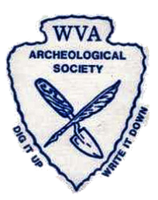 | Back to e-WV
| Back to e-WV
 The West Virginia Encyclopedia
The West Virginia Encyclopedia
 | Back to e-WV
| Back to e-WV
 The West Virginia Encyclopedia
The West Virginia Encyclopedia

The West Virginia Archeological Society was conceived in 1948 when amateur archeologist Delf Norona invited Ralph Solecki, an archeologist with the Smithsonian Institution, to Marshall County to excavate the Natrium Mound which was in imminent danger of being destroyed. While in West Virginia, Solecki suggested the formation of a state amateur archeological society.
The society was officially incorporated in January 1949, with Joseph H. Essington as president, Oscar L. Mairs as vice-president, and Delf Norona as secretary treasurer. Delf Norona was also editor of the society’s journal, West Virginia Archeologist. One of the first accomplishments of the newly formed society was the creation of a museum at the Grave Creek Mound in Moundsville, which later became the Delf Norona Museum.
The goals of the new society were to encourage the study of archeology in West Virginia and prevent excavation of mounds and other prehistoric sites except where there was immediate danger of destruction, and then only with the supervision of professional archeologists using the highest standards of archeological fieldwork. The society also wanted to discourage the indiscriminate collection of Indian artifacts.
From its modest beginnings in 1949, the West Virginia Archeological Society had grown to more than 200 members in 2005, including both professional and amateur archeologists throughout the United States. There are 11 local chapters in West Virginia. An annual meeting is held to allow dissemination of information and news from the previous year. Much of what is known of the prehistory of the state has come through the efforts of society members.
Written by Darla S. Spencer